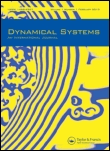
DYNAMICAL SYSTEMS-AN INTERNATIONAL JOURNAL
Scope & Guideline
Transforming Theoretical Insights into Practical Applications
Introduction
Aims and Scopes
- Dynamical Systems Theory:
Explores the behavior of dynamical systems through mathematical models, focusing on stability, chaos, and bifurcations. - Ergodic Theory:
Investigates the long-term average behavior of systems evolving over time, using concepts such as invariant measures and entropy. - Differential Equations:
Analyzes both ordinary and partial differential equations to understand the dynamics of modeled systems, including stability and periodic solutions. - Geometric Dynamics:
Studies the geometric properties of dynamical systems, including flows on manifolds and transformations, often involving topological methods. - Stochastic Dynamics:
Examines systems influenced by random processes, focusing on the interplay between deterministic and stochastic behaviors. - Thermodynamic Formalism:
Applies concepts from thermodynamics to dynamical systems, particularly in relation to measures and statistical properties. - Topological Dynamics:
Explores the properties of topological spaces in relation to dynamical systems, including continuity and convergence of system behaviors. - Multifractal Analysis:
Investigates the detailed structure of measures and their dimensions within dynamical systems, providing insights into complex behaviors.
Trending and Emerging
- Nonlinear Dynamics and Chaos:
There is a growing interest in the study of nonlinear systems, particularly those exhibiting chaotic behavior, reflecting the complexity of real-world phenomena. - Interdisciplinary Applications:
Research that bridges dynamical systems with other fields, such as biology, economics, and environmental science, is on the rise, showcasing the applicability of mathematical models. - Advanced Stochastic Modeling:
The incorporation of stochastic methods in dynamical systems is increasingly popular, addressing the need to model uncertainty and randomness in various applications. - Variational Principles and Ergodic Optimization:
Emerging research is focusing on variational approaches to optimize dynamical systems, particularly in relation to ergodic theory and statistical mechanics. - Multiscale Dynamics:
Studies that examine systems operating on multiple scales, linking microscopic and macroscopic behaviors, are becoming more prominent in the journal. - Topological and Geometric Methods:
There is an increased emphasis on using topological and geometric techniques to understand the structure and behavior of dynamical systems. - Mean Field Games and Control Theory:
Research integrating game theory with dynamical systems is emerging, particularly in contexts involving collective behavior and decision-making.
Declining or Waning
- Classical Bifurcation Theory:
Although still relevant, research focused solely on traditional bifurcation analysis has decreased as newer methodologies and interdisciplinary approaches gain traction. - Elementary Continuous Dynamical Systems:
Studies centered around simple continuous systems without complex interactions or stochastic elements appear to be waning in favor of more intricate models. - Static Equilibrium Analysis:
Research that primarily focuses on static states or equilibria in dynamical systems is less common as the field shifts towards dynamic, time-evolving behaviors. - Basic Stability Analysis:
The exploration of fundamental stability concepts without the incorporation of advanced techniques or applications has diminished, as researchers seek more comprehensive frameworks.
Similar Journals

Journal of Modern Dynamics
Unveiling Innovations in Applied Mathematics.The Journal of Modern Dynamics is a prestigious academic publication dedicated to advancing research in the fields of algebra, analysis, and applied mathematics. Published by the American Institute of Mathematical Sciences (AIMS), this journal has been a cornerstone of mathematical inquiry since its inception in 2007, and is expected to continue contributing vital knowledge through 2024. With an impressive track record, it is recognized in the 2023 category quartiles as Q1 in Algebra and Number Theory, Analysis, and Applied Mathematics, indicating its significant influence and quality within the mathematical community. Though not an open-access journal, it maintains a selective publication process to ensure that only the most rigorous and valuable research is presented to its readership. Researchers, professionals, and students alike will find this journal an essential resource for staying abreast of the latest developments and methodologies in modern mathematical dynamics.
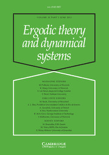
ERGODIC THEORY AND DYNAMICAL SYSTEMS
Unraveling Complexity in Dynamical SystemsERGODIC THEORY AND DYNAMICAL SYSTEMS is a premier academic journal published by Cambridge University Press, dedicated to the intricate fields of ergodic theory and dynamical systems. With an ISSN of 0143-3857 and E-ISSN 1469-4417, the journal serves a global audience from its base in the United Kingdom. Renowned for its rigorous peer-reviewed content, it boasts a prestigious Q1 classification in both Applied Mathematics and Mathematics (miscellaneous) categories as of 2023 and enjoys a significant rank in the Scopus database, highlighting its impact in the mathematical community. The journal encompasses high-quality research and innovative methodologies spanning from the foundational aspects of ergodic theory to practical applications in various fields, making it an indispensable resource for researchers, professionals, and students alike. With a commitment to advancing mathematical understanding, ERGODIC THEORY AND DYNAMICAL SYSTEMS is a vital platform for disseminating exceptional research and fostering scholarly discourse through its continuous publication cycle from 1981 to 2024.

DISCRETE AND CONTINUOUS DYNAMICAL SYSTEMS-SERIES B
Advancing Knowledge in Discrete and Continuous SystemsDISCRETE AND CONTINUOUS DYNAMICAL SYSTEMS-SERIES B, published by the American Institute of Mathematical Sciences (AIMS), is a premier journal in the fields of Applied Mathematics and Discrete Mathematics and Combinatorics. With an ISSN of 1531-3492 and an E-ISSN of 1553-524X, the journal addresses significant advances in the mathematical sciences, particularly focusing on the analysis of dynamical systems through discrete and continuous approaches. As recognized in the 2023 Scopus ranks, it holds a commendable position, being classified in the Q2 category for both its mathematical domains, reflecting its high-quality publications and substantial impact on ongoing research. With a converged publication timeline from 2001 to 2025, the journal plays an essential role in facilitating innovative mathematical discourse, making it an invaluable resource for researchers, professionals, and students eager to explore the latest developments and applications in this dynamic field. Although specific open access options are not currently stated, the journal remains committed to disseminating valuable content for those passionate about the intricacies of mathematical systems.
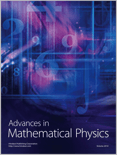
Advances in Mathematical Physics
Unlocking New Dimensions in Scientific InquiryAdvances in Mathematical Physics is a premier open-access journal published by HINDAWI LTD, dedicated to the dissemination of research in the fields of applied mathematics and physics. With its ISSN 1687-9120 and E-ISSN 1687-9139, this journal has been a vital platform for innovative studies since its inception in 2009, fostering a collaborative environment for researchers and professionals alike. The journal features a wide range of topics, including but not limited to mathematical models, computational physics, and interdisciplinary applications, thus attracting a diverse readership. Ranked in the Q3 quartile for both Applied Mathematics and Physics and Astronomy, it serves as a significant resource for academics looking to explore cutting-edge developments and theoretical advancements. With an emphasis on open accessibility, Advances in Mathematical Physics ensures that research findings are readily available to the global academic community, leveling the playing field for emerging scholars and seasoned researchers. By consistently showcasing high-quality manuscripts, the journal contributes substantially to the fields of mathematics and physics, encouraging scholarly dialogue and advancing knowledge across a myriad of applications.

Revista Matematica Complutense
Exploring New Dimensions in Mathematical ResearchRevista Matematica Complutense is a prestigious peer-reviewed journal published by SPRINGER-VERLAG ITALIA SRL, specializing in the field of mathematics. With its ISSN 1139-1138 and E-ISSN 1988-2807, the journal plays a vital role in disseminating high-quality research and fostering academic discussion within the mathematics community. Recognized for its rigorous selection process, the journal has achieved impressive rankings, holding a Q1 quartile status in the miscellaneous mathematics category as of 2023 and ranking #94 out of 399 in general mathematics according to Scopus, placing it within the 76th percentile. With a publication timeline spanning from 2008 to 2024, the Revista Matematica Complutense continues to serve as an essential resource for researchers, professionals, and students alike. Although it does not currently offer open access, the journal remains committed to advancing mathematical knowledge and providing a platform for innovative research across various mathematical disciplines.

Journal of Mathematical Analysis
Exploring New Dimensions in Mathematical AnalysisThe Journal of Mathematical Analysis, published by UNIV PRISHTINES in Serbia, offers a dedicated platform for the dissemination of innovative research in the fields of mathematical analysis and applied mathematics. With an ISSN of 2217-3412 and a convergence period from 2020 to 2024, this journal aims to foster significant advancements in both theoretical and practical aspects of mathematics. Categorized in the Q4 quartile for Analysis, Applied Mathematics, and miscellaneous Mathematics as of 2023, it serves as an essential resource for researchers and professionals alike, providing key insights into the evolving landscape of mathematical inquiry. Although it is an open access journal, facilitating global readership, its Scopus rankings reflect its emerging status, with rankings indicating a 51st percentile in Mathematics (miscellaneous) and 28th percentile in Applied Mathematics. This journal not only aims to contribute to academic discourse but also seeks to bridge gaps between mathematical theory and real-world applications, making it a vital resource for students and professionals engaged in the complexities of mathematical research.
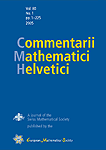
COMMENTARII MATHEMATICI HELVETICI
Fostering Global Collaboration in Mathematical ExplorationCOMMENTARII MATHEMATICI HELVETICI, published by the EUROPEAN MATHEMATICAL SOCIETY, is a premier open-access journal in the field of mathematics, specifically categorized within the Q1 quartile of miscellaneous mathematics as of 2023. With an ISSN of 0010-2571 and an E-ISSN of 1420-8946, this esteemed journal has a rich history, having commenced its publication journey in 1929 and set to continue until at least 2024. Based in Germany, it provides a valuable platform for original research and significant advancement in mathematical theory and application, appealing to researchers, professionals, and students alike. The journal's commitment to open access since 2022 further enhances its accessibility and outreach, ensuring that cutting-edge mathematical developments are readily available to a global audience. Its Scopus ranking, which places it at the 165th position out of 399 in the general mathematics category (58th percentile), exemplifies its impact and relevance in the academic community.
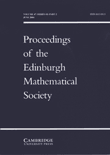
PROCEEDINGS OF THE EDINBURGH MATHEMATICAL SOCIETY
Charting new territories in mathematical thought.PROCEEDINGS OF THE EDINBURGH MATHEMATICAL SOCIETY, published by Cambridge University Press, stands as a cornerstone within the realm of mathematical research, providing a platform for original papers that push the boundaries of various mathematical disciplines. With a rich history dating back to 1883, this journal has evolved through several converged years, reflecting the dynamic nature of mathematical inquiry. As a Q2 category journal in the field of Mathematics (miscellaneous) according to the latest rankings, it situates itself within the upper tier of academic publications, offering an essential resource for researchers and professionals alike. While it currently does not offer open access options, the journal's contributions are invaluable, facilitating dialogue and collaboration among scholars. The journal's commitment to advancing mathematical knowledge makes it a vital publication for those engaged in the study and application of mathematical theories and principles.

Siberian Electronic Mathematical Reports-Sibirskie Elektronnye Matematicheskie Izvestiya
Pioneering the Future of Mathematical ResearchSiberian Electronic Mathematical Reports (Sibirskie Elektronnye Matematicheskie Izvestiya) is a prominent academic journal dedicated to the dissemination of cutting-edge research in the field of mathematics. Published by the esteemed Sobolev Institute of Mathematics in the Russian Federation, this journal provides a vital platform for scholars from around the globe to share their innovative findings and methodologies. With an ISSN of 1813-3304 and an impressive recognition within the academic community, the journal currently holds a Q2 classification in Mathematics (miscellaneous) and ranks #256 out of 399 in general mathematics according to Scopus, indicating its relevance and contribution to the field. While operating on an open-access model, Siberian Electronic Mathematical Reports ensures that high-quality research is readily accessible, promoting collaboration and knowledge sharing among researchers, professionals, and students. Covering a broad spectrum of mathematical topics, it aims to foster interdisciplinary connections and advance the understanding of mathematical principles in various applications. As it converges years from 2011 to 2024, this journal remains an essential resource for those looking to stay updated on significant advancements and contemporary discussions within the mathematical sciences.

BULLETIN OF THE BRAZILIAN MATHEMATICAL SOCIETY
Exploring Innovative Research in the Heart of MathematicsBulletin of the Brazilian Mathematical Society is a distinguished journal published by Springer Heidelberg, aimed at advancing the field of mathematics through the dissemination of research findings and scholarly discourse. With an ISSN of 1678-7544 and an E-ISSN of 1678-7714, this journal is indexed within the Q2 quartile in the field of mathematics (miscellaneous), reflecting its impact and relevance in the academic community. The journal has been recognized for its commitment to quality, as evidenced by its Scopus ranking within the 58th percentile among general mathematics publications. Since its inception in 1996, the Bulletin has served as a vital platform for mathematicians to share innovative ideas, theoretical advancements, and practical applications, making it essential reading for researchers, professionals, and students alike. Open access options are available, ensuring that the latest research is accessible to a wide audience, thereby fostering collaboration and growth within the mathematics community.